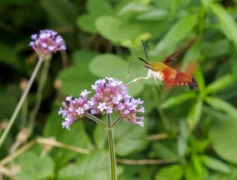
Celebrate National Moth Week
Thanks to the University of Maryland/Maryland Grows this informative article about National Moth Week. All images are from University of Maryland/Maryland Grows.
The last full week of July is National Moth Week. I encourage everyone to take a closer look at the vast diversity of moths that fill our natural world. Butterflies and moths belong to the same insect group, but moths far outnumber butterflies in species diversity. Since many moths have muted colors or fly at night, we’re largely unaware of this bounty. Let’s take a whirlwind appreciation tour of the group to illustrate the amazing, bizarre, and quirky features of this major insect order.
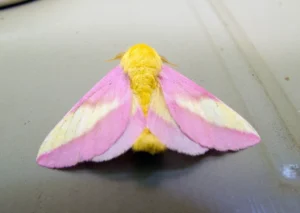

Moth adults come in all shapes and sizes, and like butterflies, wings are their most prominent feature. There are “micro-moths” whose wingspans are less than an inch. And then there are giant “silk moths” up to 6 inches, making them the largest moths in North America. (Our native silk moths are not closely related to true silk moths. They got the name because people thought they could be farmed for silk.) The wings of some moths look like mere slivers, seemingly insufficient for flight. Others are tucked around their body so they look fairly cylindrical. Some lay so flat at rest with their wings spread that you’d swear they were two-dimensional.
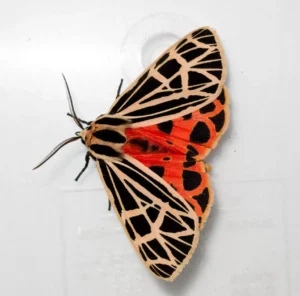

Some species unabashedly bear flashy colors and patterns in broad daylight because they’re chemically defended. They often use substances the caterpillars ingested from their host plant, similar to how Monarch butterflies use milkweed toxins. Giant Leopard Moths, white with bold black leopard spots and a metallic blue abdomen, can exude golden droplets of a distasteful substance from their shoulders when disturbed. Wasp-mimicking species use warning colors to gain protection. Few predators want to risk a sting – while other species use a different tactic and pretend to be inedible objects, like lichen, twigs, dead leaves, or even bird droppings.
Other moths hide vivid wing colors until prodded, their forewings camouflaged and covering their body at rest. When disturbed, they flash their colorful hind wings or expose eyespots that stare back at the predator. These bright patterns or eye-like designs startle a predator into rethinking an attack, making the moth appear too big to prey upon or giving it time to flee.
For seemingly defenseless creatures (no stinger, no jaws, no horns or sharp projections, and a soft body), adult moths use some clever strategies for survival. Great camouflage is the baseline strategy, but some moths can hear ultrasound produced by hunting bats. When the flying moth hears a bat homing in on it, the moth drops out of the sky and disappears from the bat’s radar. Milkweed Tussock Moth adults actually click back ultrasonically at a pursuing bat as a warning about their distaste, in case the bat ate others like it and regretted it.
It can be surprisingly hard for our dexterous fingers to pick up moths and densely-bristled caterpillars. So you can imagine other animals without hands have an even harder time if their strike isn’t spot-on. As with butterflies, wing scales can be slippery and may shed as the wings are grabbed, allowing the moth to slip away and escape.
Blooms that attract moths tend to be white or pale in color, or pink, dull red, or purple, and often have a strong, sweet scent, especially at night. As with butterflies, they prefer bloom shapes or clusters of flowers that provide a “landing platform.” This allows them to sit and sip nectar. Though some moths will hover while feeding instead. The sphinx moth group, which includes clearwings and the adults of hornworms, are the classic examples of “Did I just see a small hummingbird?” At rest, they have a silhouette more like a fighter jet.
Moth caterpillars have a dazzling array of colors, patterns, and shapes. A few are spiny and have skin-irritating properties. The cute Saddleback caterpillar that looks like a brown terrier wearing a neon-green blankie. I have been stung multiple times over the years by accidentally brushing up against them when handling plants because they’re inconspicuous when sheltering underneath leaves. It sure smarts for a few minutes, but I still think they’re beautiful and adorable.

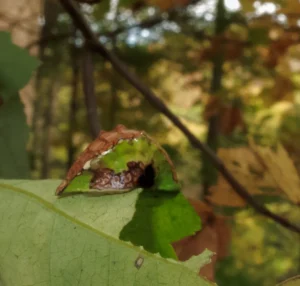
Some caterpillars resemble a walking toupee or dust bunny, like the flannel moth caterpillars (another no-touch group), or a fringed carpet that blurs their body outline. Slug caterpillars include species whose body fringe looks made of spun glass (as one species is so-named). The Monkey Slug looks like some sort of faceless alien Muppet with a fun hairdo and a herky-jerky gait. (Don’t touch that one either.)

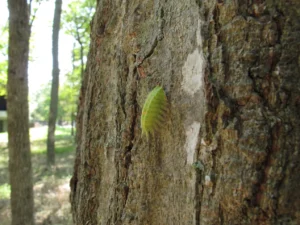
Slug family caterpillars also include featureless speed bumps, with no discernable head or legs unless flipped over. (No slime on these slugs though, thankfully.) Maybe they’re trying to mimic leaf galls, though it’s an odd choice to me if so, since galls can be attacked by parasitoid wasps or foraging birds. Some giant silk moth caterpillars have colorful knobs on their body or spiny horns that look like they belong in a punk-rock band. (With a name like Hickory Horned Devil, you can’t go wrong.) The caterpillars of other moth families have multi-hued patterns, detailed stripes, marbling, zigzagging squiggles, or big eyespots above their heads that mimic a snake staring you in the face.
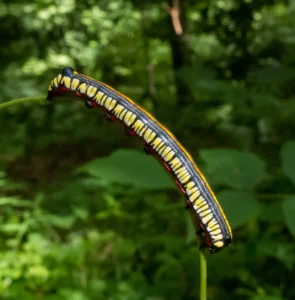
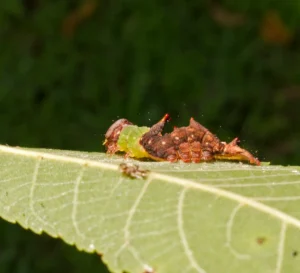
Inchworms are aptly named because their slender, long bodies inch along in a loping gait. Many disguise themselves like leaf stems or twigs when not feeding by standing on their hind legs ramrod-straight and freezing like a living statue performer. (This family’s name is Geometridae, which means “earth-measurer.” And they do, once inch at a time.) One family member, the Camouflaged Looper caterpillar, decorates itself with bits of leaf or petal that it’s eating, becoming a walking parade float of flair. As it matures and eats new things, its costume changes.
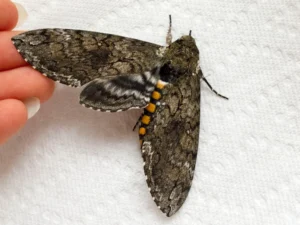
A minor handful of moth caterpillars are home or garden pests or ravenously gregarious feeders. However, the great majority do not cause us humans any trouble. Plenty of caterpillars and adult moths alike feed hungry birds, bats, beneficial wasps, predatory bugs, and other organisms that help keep our ecosystem in balance. With over 2,500 moth species documented in Maryland to date, you could make a long-term hobby out of cataloging all the species found in the smallest of yards. (A good gateway to developing an interest in all of the other wondrous insects you’ll encounter in the process!)
Want to explore more about moths? Check out the National Moth Week website for tips on finding moths, activities for kids, and more.
By Miri Talabac, Horticulturist, University of Maryland Extension Home & Garden Information Center. Miri writes the Garden Q&A for The Baltimore Sun and Washington Gardener. All photos in this post are hers. Read more by Miri.
If you are looking to buy or sell your home (with or without a garden), contact Gigi today. Oh by the way, I’m never too busy for any of your referrals!






Recent Comments